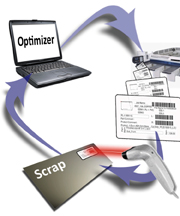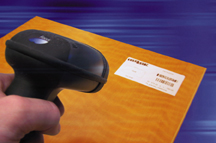|
Going Green: Reduce & Reuse through Optimization and Remnant Tracking
ÓGreenÓ itÕs the latest buzzword sweeping corporate
offices all across North America. The boss wants
to ‘go green,” the accountants agree that it sounds
 like it could save money; marketing says green sells and
sales says consumers are demanding ‘green’ products.
“So, let’s do it” everyone agrees, “Let’s go green!”
like it could save money; marketing says green sells and
sales says consumers are demanding ‘green’ products.
“So, let’s do it” everyone agrees, “Let’s go green!”
Three solar panels, one Toyota Prius and a wind operated
toilet later and the bottom line has not budged. The
customers are not beating down the doors. Sales is playing
table football rather than answering phones. What
went wrong? When did going green get so difficult?
Part of what makes being a green-friendly company so
frustrating is that it is hard to separate green trends from
truly green investments. Purchasing hybrid cars for business
trips might reduce a carbon footprint or two, but it
doesn’t really help a company produce products efficiently
and sustainably.
Solar panels on
the roof may cut
down on electricity
taken from the
grid but they don’t
address the other
wasteful and
inefficient elements
of production.
True green investments
not only
reduce the environmental
impact of a
company, they also
improve the nuts and bolts
aspects of production. They must be sustainable and provide
long-term or permanent benefits, and they should be
firmly tested and proven rather than trendy or gimmicky.
Aggressively lean companies have pursued such solutions
for years, both in software designed to tweak productivity
and in machines built for maximum efficiency. In other
words, true green tools have always been available, but
only now, as a larger conscience for conservation takes
shape, have they found a wider market.
The plastics industry has a lot to gain by going green as
quickly as possible. It’s not just a chance to alter public
perception of plastics in general; it’s also a chance to
implement time and material saving practices and technology
that can make the difference between a modern,
efficient company and
a lumbering, soon-tobe-
obsolete one.
Two options for
green technology exist
that are particularly
well-suited for the plastics
industry: optimization
and scrap recycling.
Of the two, optimization software is significantly easier to
learn and implement. Using a typical optimizer is as simple as
installing the software and entering a few basic parameters.
The optimizer typically requires a cut list of parts and a raw
material inventory in order to produce results, which come in
the form of optimized cutting patterns. The quality of the optimized
patterns depends on the level of sophistication of the optimization algorithm
powering the software.
Better algorithms, and
therefore better software
packages, will typically
cost a littlemore than bargain
bin programs.
Additionally, most
optimization packages
available today are
offered with optional
post processors for CNC
panel saws. The post
 allows optimized patterns
to be sent electronically
to the saw for cutting and eliminates error prone
and time-consuming manual entry of cutting instructions
at the saw. The boost in saw productivity alone can cover
the cost of the software within a single fiscal year. Add to
that the improvement in material efficiency, accuracy of
reporting and estimating, as well as a range of other benefits,
and optimization easily becomes one of the best software
investments a company can make.
allows optimized patterns
to be sent electronically
to the saw for cutting and eliminates error prone
and time-consuming manual entry of cutting instructions
at the saw. The boost in saw productivity alone can cover
the cost of the software within a single fiscal year. Add to
that the improvement in material efficiency, accuracy of
reporting and estimating, as well as a range of other benefits,
and optimization easily becomes one of the best software
investments a company can make.
The second, more intensive option, often goes hand-inhand
with optimization software. Scrap recycling is a logical
method to improving material efficiency and reducing
waste material. In a typical system, usable scrap pieces
from a previous job are added back into inventory for
future use. The complexity of tracking scrap pieces and
having them on hand when called for can scrap (no pun
intended) even the best intentions and meticulous organization.
Production won’t wait for Bob to hunt down piece
number 1249B from the chaos in the warehouse, they’ll
just grab a fresh sheet. Over time, the discrepancy between
inventory actually on hand and inventory according to the
software grows so large than scrap
recycling is abandoned, if not officially,
then certainly in practice on
the shop floor.
Fortunately, technology has
advanced and the gap between
virtual and real, at least in terms
of real-time inventory tracking, is
diminishing. Most modern CNC
saw equipment can print part
labels in real-time, assigning
unique IDs stored in barcodes to
each part. The barcodes can contain
a variety of information that
can be retrieved quickly with a
commercially available barcode
scanner. Among other things, the
barcode can store the material
type and dimensions of a scrap
piece, which is laid aside until it
can be used. If the optimization
software is
 capable of interacting
with bar code scanners, the saw
operator simply scans
the label on the scrap
piece he wants to use
and it is entered into
the optimizer’s inventory.
If the optimizer doesn’t
use it, the piece
remains on the shelf for
future use. Given the
relative cost of some
plastics, their multitude
of uses, and their infinite
shelf life, a sophisticated
scrap management
system save
untold thousands in raw material costs.
capable of interacting
with bar code scanners, the saw
operator simply scans
the label on the scrap
piece he wants to use
and it is entered into
the optimizer’s inventory.
If the optimizer doesn’t
use it, the piece
remains on the shelf for
future use. Given the
relative cost of some
plastics, their multitude
of uses, and their infinite
shelf life, a sophisticated
scrap management
system save
untold thousands in raw material costs.
No matter where you stand regarding the green movement,
optimization and scrap management are a good
place for plastics manufacturers to get their feet wet. If
you’re still skeptical of the “green revolution,” know that
optimization has been around for decades. A good quality
optimizer is the coalescence of many years of refinement
and testing, and can work on almost any machine in any
manufacturing environment. On the other hand, if you’re
fully committed to “going green” then optimization and
scrap management are a perfect fit, particularly in the
plastics industry. You don’t even have to drive the Prius
back to the dealership or cancel that order for the wind
operated toilet – every little bit helps!
Wishing you good luck in going green.
Written by David Talbot and Roman Liedel, Eurosoft.
For more information, contact them at Eurosoft,
Inc., 1628 Old Apex Road, Cary, NC 27513, 919-468-3003, Fax: 919-468-6374, E-mail: david@eurosoftinc.com, Web: www.eurosoftinc.com.
|